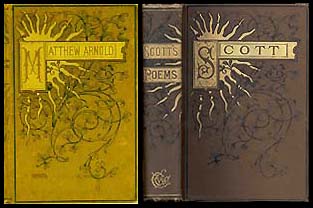

Publishers' Bindings and Series
Until 1820, most books were sold in paper covers to be bound later. These covers could be plain, printed, marbled, or backed with a thin board. Pasted paper labels were often used to indicate the title.
| Scott, Walter, Sir. Halidon Hill: A Dramatic Sketch, from Scottish History. Philadelphia: H.C. Carey & I. Lea, 1822. |
When William Pickering published his famous Diamond Classics series beginning in 1820, he introduced the use of cloth as a publisher’s covering material and used separately made cases for the binding. Most books are still made the same way today.
| Miniature Pickering
Books Alighieri, Dante. La Divina Commedia. 2 vols. London: G. Pickering, 1822. Petrarca, Francesco. Le Rime del Petrarca. London: G. Pickering, 1822. |
Series of popular literature were published in the thousands from the 1870s through the 1910s and were identified by distinctive covers so that they could be immediately recognized. We are familiar today with this method of marketing through Loeb’s Classical Library, Modern Library, children’s books, and the genres of fantasy and romance writings. Sets of works of famous authors were also popular for the home library.
 |
Arnold,
Matthew. Poems by Matthew Arnold. New York:
Thomas Y. Crowell, ca. 1890. Scott, Walter, Sir. The Poetical Works of Sir Walter Scott. New York: Thomas Y. Crowell, ca. 1890. |
Pope, Alexander. The Poetical Works of Alexander Pope. Boston: D. Lothrop & Company, 1883.
|
In 1880 the large firm of Macmillan started binding works of respectable literature in dark blue cloth blocked with gold. This elegant style started a trend among other publishers.
Herbert, George. The Works of George Herbert in Prose and Verse, Edited from the Latest Editions, with Memoir, Explanatory Notes, Etc. New York: Thomas Y. Crowell, 1880. |
| Ball, Nicholas. The Pioneers of '49: A History of the Excursion of the Society of California Pioneers of New England, from Boston to the Leading Cities of the Golden State, April 10-May 17, 1890. Boston: Lee and Shepard, 1891. |
“Owen Meredith” was the pen-name of Edward Robert Bulwer Lytton, Earl of Lytton, Viceroy of India and a popular Victorian poet. Lucile, a romantic yet witty novel in verse, went through hundreds of editions (legitimate and pirated) and hundreds of thousands of copies. The three editions shown below were all published by Thomas Y. Crowell of New York within the decade of the 1880s. Each was meant to appeal to a different level of society: (l-r) a lady’s boudoir book, and a cheap edition, a family library or parlor edition.
Wood-engraving, combined with the popularity of scandalous pictures in Victorian newspapers, brought about the “yellow back” railway novel and the “penny dreadful” or “dime novel” in the 1880s. The former were adventure books and historical novels with glazed paper covers (most often yellow, but also green, blue, or red) and a scene to attract the reader. The latter were the forerunner of comic books, with wild boy’s stories and lurid illustrations in a tabloid format.
Lawson, W. B. Dashing Diamond Dick, Jr. in Danger, or a Queer Game
at Maverick. New York: Street & Smith, 1900.
|